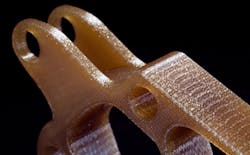The use of 3D printing has grown substantially over the past few years. According to a recent 2019 study conducted by Jabil, a provider of manufacturing, supply chain, and product management services, more than 50% of respondents were using 3D printing to produce production parts. In 2017, when Jabil last conducted this survey, only a quarter of respondents were using 3D printing for that purpose. With this level of growth comes the need for greater incorporation of 3D printing into a manufacturer’s overall production strategy. And that means integration with ERP (enterprise resource planning) systems.
“3D printing has limited capacity in terms of numbers of parts, so planning around these constraints may require a manufacturer to consider buffer capacity in the number of printers or at least strategic sourcing of otherwise unfillable orders to other entities with excess,” says Bill Leedale, senior advisor at IFS North America, a supplier of ERP software. “This is where having ERP as an overarching system to aid additive manufacturing operations is crucial.”
Leedale explains that, becauseERP software plays a key role in optimizing production sequencing, the software must sequence parts based on certain characteristics so they can go through the printing and subsequent processes as quickly and inexpensively as possible. “Optimal production sequencing gets the right parts into each step of production at the right time for faster turn times,” he says. “Work should be handed off directly from one workstation to the next instead of allowing parts to linger as work-in-progress.”
When configuring ERP software to accommodate additive manufacturing, Leedale advises manufacturers to “make good use of whatever demand-driven materials requirements planning (DDMRP) functionality they have access to. When DDMRP capability is embedded in ERP, it can help manufacturers prepare for demand shocks with strategic buffer inventories of specific materials.”
According to Leedale, using DDMRP and ERP in the additive manufacturing process can help manufacturers adapt to demand shocks in four ways:
Faster parts production. “3D printing enables manufacturers to design and produce parts that would be difficult or expensive to manufacture using traditional methods,” Leedale says. “However, to make production faster and more efficient, it needs to make use of DDMRP to plan around bottlenecks and constraints in the process. Since one significant bottleneck will be the 3D printing unit itself, it is crucial to determine how many of these machines a facility needs—given a balance of demand and required utilization rate—to achieve ROI (return on investment).”
Reduced spares and repairs inventory. Because additive manufacturing can help reduce a manufacturer’s spares and repairs inventory, the resulting “streamlined inventory enables manufacturers to focus efforts on maintaining their own assets, manufacture engineer-to-order products, and even move into new revenue streams to support customers in aftermarket service contracts,” he says.
Waste reduction. Since 3D printing is an additive process—producing a discrete item or part—material removed during blasting and machining may be reground and used over again, which makes the method a good choice for manufacturers prioritizing waste reduction, notes Leedale.
Keeping up with service needs. Many of the quality problems associated with 3D printing are due to miscalibration of the machine in terms of temperature, nozzle size or speed, says Leedale. For this reason, many manufacturers rely on annual service contracts with their equipment vendor to handle inspection and re-calibration. “The manufacturer should make sure they have the software tools to support a condition-based maintenance program or the contract management tools to proactively manage deliverables against a contract,” he says. “ERP can provide visibility and traceability into the service process to keep 3D printers operational.”
Leaders relevant to this article:



